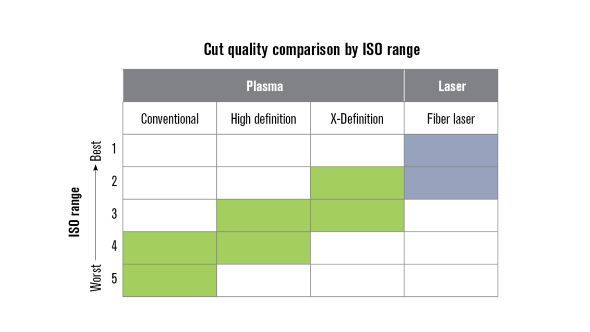Plasma vs. Laser Cutter: Unveiling the Debate with Hypertherm's Insightful Study
|
The debate over which cutting technology reigns supreme, plasma or laser, has long been a topic of discussion among metal fabricators. Fortunately, thanks to Hypertherm's insightful study, we now have a comprehensive comparison covering productivity and cost, shedding light on the strengths and nuances of both processes. |
|
One of the key takeaways from the article is the inherent differences in cutting mechanisms between plasma and laser technologies. Plasma cutting harnesses a high-velocity jet of ionised gas to melt through metal, making it a versatile choice for various materials and thicknesses. Conversely, laser cutting utilises a focused beam of light to vaporize material with unparalleled precision, making it ideal for intricate designs and delicate work. Plasma excels in rapid cutting of thicker materials, laser cutting shines in intricate designs and thin material applications. This nuanced comparison underscores the significance of choosing the right technology to match specific project demands. |
Here are some key insights gleaned from Hypertherm's research: |
 |
|
A helpful reference to compare the two technologies’ cut quality is ISO 9013, an international standard for classifying the quality of parts cut with a thermal process. ISO 9013 classifies a method’s angularity - a measurement of deviation from perpendicular - in ranges from 1 (the least deviation) to 5 (the most deviation.)With a cutting machine offering superior motion capabilities, X-Definition plasma delivers ISO Range 2 cuts on material less than 10 mm (3/8″) thick and Range 3 cut quality on thicker material1. |
 |
|
When cutting metals over 16 mm (5/8”), plasma cuts faster than fiber laser. This translates to higher productivity, fewer bottlenecks, better on-time delivery1. |
 |
|
When considering the direct operating costs of a cutting operation, plasma often costs less per foot/meter for thicker metals due to refined processes and reduced gas consumption. Even where fiber laser direct operating costs are lower, as with thin metals, make sure you calculate the electricity consumption and gas consumption requirements of the fiber laser system1. |
| Read full Hypertherm research here: Plasma cutting vs. fiber laser cutting. |
At ARC Welding & Safety Supplies,we are honored to partner with Hypertherm as authorized distributors, offering top-quality cutting solutions and expert guidance to metal fabricators across New Zealand. If you're ready to explore the Hypertherm range or have any inquiries, feel free to reach out to us. |
|
|
| 1. Hypertherm: Plasma cutting vs. fiber laser cutting |
